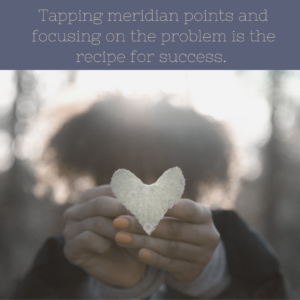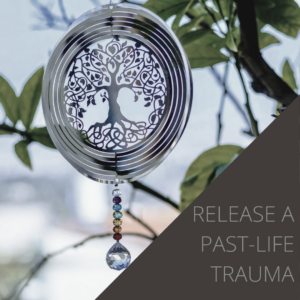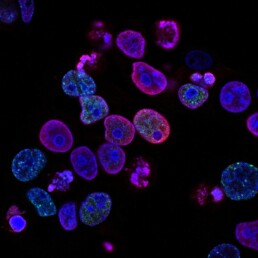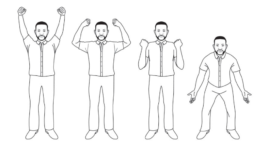Studies that support energy psychology: a review of methods used by lay counselors
If you are like me, you like to know about studies that support energy psychology - the approaches we are using! This blog explains findings of a study of energy methods used by lay counselors in areas that were affected by man-made and natural disasters.
The Bulletin of the World Health Organization published a systematic review and meta-analysis of mental health interventions by lay counselors. Suzanne Connolly, a Thought Field Therapy (TFT) practitioner, trainer, and researcher, and ACEP member, led the research team, which included Jan Warner and Jenny Edwards. She investigated various mental health interventions used around the world, particularly in areas with poor mental health infrastructure. Results showed that professionally trained lay counselors who use these methods create significant improvements in mental health. Overall, among the interventions studied, TFT performed well, receiving medium to high effect sizes in a shorter time with faster training.
Study methods
Connolly and her colleagues searched published literature for randomized controlled studies of mental health services delivered by laypeople that were trained by professionals. The studies measured a variety of mental health concerns. All of the studies were published between 2000 and 2019. Of the 19 studies identified, ten were conducted in Africa and nine in Asia.
The studies covered a variety of conditions.
- 13 studied PTSD
- 3 studied depression
- 2 studied alcohol dependence
- 1 studied mixed depression and anxiety
The techniques used included
- CBT: 6 studies
- Behavior therapy and psychoeducation: 6 studies
- TFT: 3 studies
- Narrative exposure therapy (NET): 2 studies
- Interpersonal psychotherapy: 2 studies
The time it took to train the lay counselors varied widely, ranging from just two days (TFT) for the shortest, and one year (classroom-based CBT) for the longest. Significantly, there was a wide variety in treatment duration varied widely as well. The shortest duration of treatment again was in the TFT studies, which lasted one day; the longest was the classroom-based CBT, which included 15 sessions. The largest study included nearly 1000 participants, using interpersonal therapy to treat depression; the smallest was another interpersonal therapy study to treat PTSD and included just 20 participants.
Study results
The effect of the various modalities varied widely as well. Hedge's g determined effect size. Overall, therapies delivered by professionally trained lay counselors had a medium effect size, suggesting that this is indeed a viable way to bring mental health treatment to areas in need.
Fourteen of the 20 studies trials found significant effects. Of those, three found small effects; six found medium effects; and five found large effects. Six studies found no effect. Among all the studies, the TFT studies fared comparatively well, with two having large effect sizes and one having a medium effect size.
Why this matters
There is a shortage of mental health workers in the world, particularly in low- and middle-income countries. The problem comes into stark relief in the aftermath of natural or manmade disasters. Because of this, the World Health Organization (WHO) has recommended enlisting community members to bridge this gap. While the goal of the study was to demonstrate the effectiveness of therapies delivered by professionally trained lay counselors, the data also show that TFT produces impressive results with the shortest amount of training and treatment time.
A win for energy psychology
Of the 19 studies included in the analysis, three used the energy psychology technique TFT. As can be seen, TFT delivered solid results in just one day of treatment delivered after just two days of training. Accordingly, this positions TFT well as a relatively easy to learn and implement, effective strategy to address mental health issues in lower- and middle-income countries where there is a lack of robust mental health infrastructure. This study also adds to the list of studies that support energy psychology.
If you'd like to learn TFT, you can study with Suzanne Connolly herself in ACEP's online TFT training.. If you would like to use energy-based methods like this in your own healing, contact me.
Stress-inflammation-disease: A molecular story
This blog is partly the story of how stress acts on a molecular level to increase our chances of getting cancer and of cancer progression. The more important part is the story of how de-stressing might help our immune systems function better and help to improve our health. Research from the field of psychoneuroimmunology – psychology, neurology, and disease – helps us to understand, in a practical way, how stress affects our bodies. Understanding the stress-inflammation-disease cycle can empower us to heal. In deepening our understanding of what is happening in our bodies, perhaps we can thoughtfully harness our mind-body-spirit approach and use it to our advantage.
Inflammation: A molecular story
We have heard a lot about inflammation and disease. But what exactly is inflammation, and why is it harmful? Inflammation happens in our bodies, and it’s not all bad. In fact, inflammation is vital for healing; it’s how our bodies fight disease and repair damage. The problem is with chronic inflammation. This increases the risk of a variety of diseases.
A group of chemical messengers called cytokines play an important role in inflammation. Cytokines are secreted by cells to regulate the body’s immune response. When a cell secretes a cytokine, that cytokine binds to other cells. The receiving cells carry out activities based on the cytokine’s message. These activities can include cell inflammation, growth (proliferation), and death (apoptosis).
Cytokines and inflammation
Some cytokines cause inflammatory responses. Immune system cells typically secrete these cytokines. It works like this: when a cell is injured by bacteria, trauma, toxins, etc., it releases chemicals which cause fluid to enter the cells; this signals the immune system to repair damaged tissue and fight infections.
When our bodies are functioning well, cytokines are rapidly released at the area of infection, which causes inflammation. The inflammation calls other immune system cells to come to the area for repair or to fight infection. When the crisis is over, anti-inflammatory cytokines come to the site to counteract pro-inflammatory activity and calm the immune response. Our bodies need to have a healthy balance between inflammatory and anti-inflammatory cytokines. An imbalance leads to chronic inflammation and diseases like cancer.
Types of cytokines
There are several subsets of cytokines. One of these are interleukins, which play an important role in inflammation. They also regulate cell growth. Researchers have been investigating the role of interleukins in cancer. The pro-inflammatory interleukins IL-1 and IL-6 seem to play roles in breast cancer tumor growth, as does the anti-inflammatory IL-4. Another cytokine that is important in cancer tumor growth and apoptosis is Tumor Necrotic Factor alpha (TNF α). Type II Interferon or IFNγ is a cytokine that activates macrophages, the large white blood cells that gobble up infections and unhealthy cells; IFNγ is also implicated in cancer.
Cytokines are produced by certain T lymphocytes (a kind of white blood cell). Th1 lymphocytes produce the cytokines IL-1β, IL-2, IL-12, TNF-α, and IFN-γ, which are associated with fighting infections. Th2 lymphocytes produce the cytokines IL-4, IL-5, and IL-10, which are associated with tumor growth and metastases. Chronic stress and inflammation seem to lead to a dampening of the production of Th1 lymphocytes and the anti-inflammatory cytokines they produce, and an overproduction of Th2 lymphocytes and the inflammatory cytokines they produce. However, it’s not a simple, too-many-inflammatory/not-enough-anti-inflammatory cytokine equation. The system is complex, and each cytokine can, paradoxically, help or harm tumor growth.
It’s not all about the genes: The role of RNA
The “maybe good news, maybe bad news” effect of these cytokines is probably the result of the complex micro-environment in which they exist. However, one common denominator seems to be the action of these cytokines on the transcription of ribonucleic acid, or RNA. RNA is the stuff inside all cells that allows for protein synthesis. Protein synthesis is essential for life; making protein is important because proteins give our bodies their structure and allow us to metabolize food, repair and rebuild tissue, maintain fluid balance, and regulate pH.
RNA helps produce, or synthesize, the proteins; DNA holds all the instructions for producing them. The instructions are part of our genetic code, contained in the double-helix string of paired molecules, or nucleotides, inside the nuclei of our cells.
RNA in action
RNA carries out the instructions, creating proteins in a process called transcription. First, DNA’s double helix splits at the transcription site. Next, proteins (transcription factors) and enzymes (RNA polymerase) bind to and copy the material in the DNA strand, thus creating a single strand copy of the gene. This strand moves outside the nucleus and into the cytoplasm, over to the ribosomes (the factory of the cells) where it binds with more RNA and certain amino acids to create proteins – including cytokines.
While we often focus on DNA and our genes as the source of illness, that is not the entire story. The problem could occur at the RNA transcription level. Even when DNA is correctly sequenced, RNA might make changes that allow for tumor growth and proliferation. There is a specific transcription factor, nuclear factor kappa-beta, which regulates several cytokines including interleukins and TNF. It seems that errors in this transcription process are at play in the process by which chronic inflammation can cause disease.
The HPA axis: Stress and immune function
The hypothalamus-pituitary-adrenal axis helps our bodies respond to stress. Neurons from the hypothalamus (a part of your brain’s emotional or limbic system) send signals to the pituitary body, which is often called the master gland. Then, the pituitary secretes a hormone called ACTH that signals the adrenals to release the stress hormone cortisol. Cortisol causes a release of glucose in the blood and raises our heart rate and blood pressure.
We have all felt the effects of cortisol. When we are frightened, it, along with adrenaline, gives us that rush. When we are stressed or anxious about something, it gives us that uneasy feeling. Remember being a kid listening to a scary story: even if it was for fun, your brain’s hypothalamus sent signals to your pituitary body, asking it to release ACTH. That hormone went to your adrenal glands, all the way down by your kidneys, and asked them to release cortisol. The cortisol flowed into your blood stream, increasing your blood pressure and heart rate; it also made your blood sugar levels increase so you would have energy to run away. You were ready to run, even though the scary story was just for fun. A well-functioning HPA axis is even more useful when the stress you face is real.
Stress: The good, the bad, and the ugly
However (and thankfully) most of the time our stress is not really an imminent threat. Our modern stressors are less likely caused by the bear in the woods than by thinking about and relating to ongoing stressful things like horrible bosses, dysfunctional relationships, health concerns, or dwindling bank accounts. These stresses tend to be chronic, and they are not good for us.
When we experience chronic stress, our HPA axis can be come dysregulated. Instead of a short-term burst of cortisol, we have chronically elevated levels; overtime, the levels become depleted, so we don’t have store available during a crisis. Generally, chronic stress seems to lead to an elevated level of cortisol, with its resultant increase in blood sugar and cardiovascular activation. In some cases, chronic stress, especially the kind experienced during childhood, seems to decrease the availability of ACTH and cortisol when needed. In both cases, an inefficient stress response leads to chronic inflammation and an increased risk of disease.
Circling back to the cytokines: Chronic psychological stress and the cortisol it releases seem to cause our bodies to produce more Th2 cells than Th1 cells. This imbalance might cause our bodies to produce more of the cytokines that are associated with tumor growth and metastasis. Again, there is not a simple causal relationship between these cytokines and every kind of cancer risk. In some cases, a correlation seems to be at play.
About those genes: BRCA, cortisol, and cancer
We have all heard of the BRCA mutations, which increase the risk of developing breast and gynecologic cancers. BRCA genes are important in DNA repair and apoptosis. Some studies, like this one, have shown that, when cortisol levels are high, cells do not efficient repair damage and they experience increased oxidative stress. The same study found that women who had elevated cortisol levels were more likely to develop cancer. Other studies have shown that BRCA1 is downregulated when exposed to high cortisol levels, making it less efficient at repair and apoptosis. Stress seems to directly impact the function of BRCA. Indeed, stress could be the link that connects this gene to the development of breast cancer.
Hope
In this blog, we explored a world of microscopic interactions which seem come together to increase our likelihood of getting cancer. While researchers are learning more, we clearly have not figured out the whole picture. What seems to be at play is a combination of events: exposure to a carcinogen, a genetic predisposition, faulty RNA, an imbalanced immune system, stress and the HPA axis dysregulation with its consequent hormonal exposure – all of these paint part of a picture of what might have gone awry.
What can we do about it now? We have seen how stress seems to be directly related to disease progression; might de-stressing help stop or slow disease progress? We understand the anti-stress benefits of meditation, mindfulness, yoga, and some forms of talk therapy. Research is underway, demonstrating the effectiveness of various practices in slowing disease progress. Now is the time to hold up hope for ourselves and our community as we harness the mind-body-spirit connection to increase our wellness and improve our health outcomes.
If you want to learn some techniques to reduce stress, check out these body-based tools, and HeartMath's Quick Coherence Technique. If you want to set up a session to work on the underlying issues, contact me!
Feeling angry? Try this.
Want to learn techniques to release anger? You’re in the right place. This blog teaches you an easy tool you can use the next time you are feeling angry.
One of the fastest and most effective ways to release anger is to blow it out, using the Stress Blow-Out. This simple body-based technique helps your body relax as you release that buildup of anger. This technique is also helpful if you're feeling stuck or upset and need to Let It Go. This technique comes from Donna Eden. Practice the technique right now by watching the video below and following along. You can also download written instructions in English, Spanish, and Portuguese.
How it Works
Lift both hands over your head, clenching your fists hard. Take a deep breath and hold it for a few seconds. Then pull your hands down fast, blowing the out air out with a ‘whoosh!’ Bend your knees as you go, and open your hands when your arms are fully extended. You can repeat this three to five times.
Why It Works
By using energy-based techniques like the Stress Blow-Out, you help your body release excess emotions like anger and irritation. This allows you to feel relaxed, centered, and grounded. Involving our bodies helps us to release pent-up energy. The big movement is also clearing out your energy field.
If you haven’t given the Stress Blow-Out a try yet, do it now. Take notice of how your body feels both before and after you use the technique. This technique is just one of many you can use when you need calming and balancing.
More Techniques to use when You are Feeling Angry
If you found the Stress Blow-Out helpful, here are a few more tools you can use to reduce anger: The Balance HookUp and the Healing Head Hold. All of the videos and techniques in my "Try This" series were created by ACEP's Humanitarian Committee in order to help people heal by spreading the word about the powerful effects of energy psychology techniques. I invite you to help by sharing this information!
If you want to learn tools like this to help manage your feelings, contact me.
Video Resources Provided by the ACEP Humanitarian Committee
The mission of the ACEP Humanitarian Committee is to develop and implement humanitarian projects that alleviate emotional distress caused by catastrophic natural and man-made events around the globe. We do this by encouraging and assisting ACEP members in developing humanitarian projects that utilize recognized energy psychology and other modalities that meet ACEP’s standards and guidelines. Learn more here.
Treating emotions associated with cancer using Energy Psychology
If you are reading this blog, you probably already know how a cancer diagnosis affects our emotional wellbeing. You are not alone: Depression rates in the US jump four-fold among cancer patients, with nearly a quarter of cancer patients experiencing depression. Anxiety rates among cancer patients in the US climb as well, affecting nearly a fifth of people with cancer. Many people with cancer report experiencing PTSD-like symptoms, and almost all say they experience feelings of overwhelm. Clearly we need tools for treating emotions associated with cancer. Energy Psychology tools fit the bill, for reasons we will explore in this article.
Unfortunately, the system in the US does not universally encompass mental and emotional care in cancer treatment. This has costs, not only in terms of emotional wellbeing, but perhaps in resilience and ability to heal. Energy psychology techniques may fill the emotional need of cancer patients particularly well. These modalities often focus on addressing and clearing underlying emotional traumas. They also provide effective self-soothing routines that may help cancer patients navigate the emotions that often accompany diagnosis.
Mental Health Matters
The stress-inflammation-disease cycle
Researchers in the field of cardiovascular disease were the first to identify the role of stress in disease. Today, most of us understand fact that stress leads to disease. And a cancer diagnosis itself is stressful! This explains why treating emotions associated with cancer is so important.
Episodic stress is an important part of life, mediating injury and pathogenic assault. When pathogens attack cells, or cells are injured, they become inflamed, holding fluid. This is because of a cascade of activity on the molecular level. In other cases, it is the threat of assault that causes inflammation. In these cases, the hypothalamus (a region in the limbic brain) signals to the pituitary body (often called the master gland) to tell the adrenal glands to release adrenaline. This cycle is known as the HPA axis.
Under normal stress conditions, this action reduces inflammation. However, when people experience chronic stress, this cycle of inflammation–healing–homeostasis is disrupted. Researchers have found that this is at least partly because an immune system cell or cytokine called interleukin 6 (IL6) triggers inflammation in times of stress. And IL6 is implicated in cancer, as well as a host of other diseases including diabetes, autoimmune disease, obesity, depression, and anxiety.
It might not be unreasonable, then, to wonder if decreasing stress levels might assist in the healing response of those with cancer diagnoses, and to prevent cancer occurrence in the first place.
With its capacity to decrease stress, could Energy Psychology play a role in remission?
Kelly Turner studied cases of unexpected and medically unexplained remission, conducting interviews with people who had experienced these seemingly miraculous cures. She distilled the data and found seven key factors that were almost universal. She writes about them in her book Radical Remission.
Among the factors identified are eliminating negative emotions and increasing positive emotions. While the sentence is easy to write, achieving the essence is not! However, EP methods are known for their ability to heal underlying traumas and the ensuing energy disruptions, which lead to distress and may contribute to disease.
The research: treating the emotions associated with cancer using EP
EFT improves physiological markers of health
Bach et al published a study in the Journal of Evidence-Based Integrative Medicine in 2019, examining the psychological and physiological outcomes for people (n=203) who attended a four-day EFT workshop. In this study, participants experienced reductions in anxiety, depression, PTSD, pain, and cravings, and an increase in happiness. Several physiological markers were taken of some study participants (n=31). Interestingly, they found a significant increase in Immunoglobin A (SigA), an antibody that plays a role in immune function, and decreases in resting heart rate, cortisol, and blood pressure.
EFT for chemo brain
Laura Track et al conducted a randomized, controlled study of EFT for cancer-related cognitive impairment (CRCI; aka “chemo brain”). The study was published by EClinicalNews in August of 2021. Participants were 121 patients in Belgium and the UK who met diagnostic criteria for cognitive impairment. The study lasted 16 weeks. For the first eight weeks, half of the participants received instruction in EFT tapping and tapped with a clinician and at home, while the other half waited. They all took a second cognitive test and other assessments. Then, the second group got EFT training. Not surprisingly, the difference between groups at eight weeks was significant, with the tapping group achieving a reduction in cognitive impairment. The second group “caught up” at 16-weeks, after they had done eight weeks of tapping.
EFT for side effects of treatment
Baker and Hoffman published a study in 2014, investigating the effect of EFT tapping on depression, anxiety, and side-effects of hormone therapies used to treat some types of breast cancer. The side effects include pain, fatigue, and menopausal symptoms such as hot flashes and night sweats. The study participants (n=41) received three weeks of instructed EFT and we assigned self-tapping for the next nine weeks. Again, the participants achieved statistically significant improvements in total mood, depression, anxiety, and fatigue, as well as a reduction in hot flashes and the experience of hot flash as problematic.
Pain in cancer patients
Niken, Wahyuningsih, and Prasetyorini published a case study in 2020, documenting the experience of four cancer patients who complained of moderate to severe pain. They found that using EFT reduced the experience of pain.
Spiritual EFT for self-concept of women with mastectomy
Afriyanti and Wenni used Spiritual EFT in a quasi-experimental study of 33 women who had had mastectomies. At baseline, only three had a good self-concept. After three days of tapping, the number had risen to ten. This improvement was statistically significant and gives rise to some questions, including what would happen if the intervention lasted more than three days.
Pilot study in Australia found EFT helped decrease anxiety in cancer patients
Peta Stapleton conducted a pilot study of group EFT for palliative care among cancer patients. Researchers randomly assigned thirty-two cancer patients to either EFT or treatment as usual (TAU). The EFT group received two-hour EFT sessions, led by a trained psychologist, for four weeks. Delivery moved from in-person to Zoom after the Covid-19 lockdown. All patients completed assessments for depression, anxiety, PTSD, quality of life, happiness, pain, hope, and meaning of life. After treatment, the EFT group received significant reductions in anxiety, and trends toward improvements in meaning of life, quality of life, PTSD and happiness. The TAU group did not receive any benefits. These results were compelling enough to launch a full study, which is now underway.
Advanced Integrative Therapy (AIT)
Advanced Integrative Therapy, or AIT, is another energy psychology technique. Practitioners of AIT have used this energy psychology technique to address the underlying emotional causes of cancer. They are seeing good enough anecdotal evidence to warrant a full study. Today, a study of AIT and cancer is underway, with preliminary data expected this spring.
Stories from the (virtual) treatment room
Mis-hearing leads to PTSD-like symptoms, relieved with EFT
A woman in her early 50’s was diagnosed with breast cancer. As often happens to people diagnosed with cancer, she was in the throes of shock and distress when she met with her oncologist. Clients often report that they can’t “take in” what their doctors are telling them. They leave appointments wondering what was just said, and realizing that they have many questions they forgot to ask. In this case, the client mis-heard “grade 4 tumor” as “stage 4 cancer.”
Although she quickly realized her error and understood that she did not have metastatic breast cancer, she was extremely distressed about the idea and still felt terrified. In our individual counseling session, we tapped together using emotional freedom techniques (EFT) Tearless Trauma and Tell the Story protocols. During our session, we were able to reduce her distress and worked to clear her trauma. Thankfully, she experienced a reduction in subjective units of distress (SUDs) from a ten to a zero. Moreover, she stayed clear of distress in subsequent counseling sessions four to six weeks later.
Fear of recurrence
For women with breast cancer who have some understanding of the mind-body connection, fear of recurrence can create what seems like a trap. These women often express a fear that their fear is going to create a negative outcome. Effortfully trying not to think about it, or to think positive thoughts instead, often proves futile. One woman in such a paradoxical trap came for therapy and we began using EFT to manage her fear of recurrence. Her distress reduced during the session. Additionally, having EFT as a self-help tool provided her with a coping tool that she used regularly to help manage her fear as it arose.
Experience of tapping in groups
In regular facilitated support groups, women with various cancer types use EFT at the beginning of the sessions to come together and relax. Often, we use the “constricted breathing” technique to demonstrate and reinforce the physiological effect of tapping. (In this technique, tapping on constricted breathing allows the breath to become fuller and more satisfying/less constricted). Most women achieve a feeling of un-constricted breath after one round of tapping. They also report feeling more relaxed, more present, and, in one case, feeling “warm and tingly.”
A vision for the future
Because of the deep emotional distress that cancer patients often feel, it is important to provide them with tools and support to reduce these feelings. Again, we need to focus on treating emotions associated with cancer. Energy psychology techniques have a demonstrated ability to reduce subjective distress. Moreover, these are tools that therapists can use clinically, and clients can use as ongoing self-help practices. Incorporating mind-body techniques such as these for the management of mood and stress in people with cancer can provide a tremendous benefit to patients' subjective wellbeing. Because of the role of stress in disease progression, these tools may even improve outcomes.
Feeling anxious? Try this.
Try this the next time you feel anxious or afraid.
If you want to learn how to feel better fast next time you're feeling anxious, you have come to the right place. This blog teaches you an easy tool you can use to help you feel connected and safe.
One of the fastest and most effective ways to restore a sense of safety is to give yourself a calming hug. This simple body-based technique helps your body feel calm, centered, and grounded by harmonizing the spleen and triple-warmer meridians. Best of all, you could do this in public, and nobody would notice! Practice the technique right now by watching the video below and following along. You can also download written instructions in English, Spanish, and Portuguese.
How it Works
It's so simple to do! Cross your arms over your chest, with one hand resting on the side of your chest in the area of a bra strap, and the other resting above your opposite elbow. Hold for a minute, and switch sides.
Why It Works
The calming hug is an energy psychology technique that helps your body balance the yin and yang energies that flow along your triple warmer (that's the hand above the elbow) and spleen (that's the hand in the bra strap area) meridians. This allows you to feel calm and grounded. The technique is also helpful if you are having trouble focusing.
If you haven’t given the Calming Hug a try yet, do it now. Take notice of how your body feels both before and after you use the technique. This technique is just one of many body-based techniques you can use whenever you are feeling anxious or scared.
More Techniques to Feel Better Fast
If you found the Calming Hug helpful, here are a few more tools you can use next time you feel scared or anxious: Simpliefied Self-Havening, the Soothing Butterfly Hug, and Calm Breathing. All of the videos and techniques in our "Try This" series were created by ACEP's Humanitarian Committee in order to help people heal by spreading the word about the powerful effects of energy psychology techniques. We invite you to help by sharing this information!
If you want to explore body-based tools like this to help calm your emotions, contact me.
What is Energy Psychology?
What is Energy psychology (EP)? It is a set of somatic, holistically influenced, evidence-based tools and therapeutic interventions that help people manage their mental health issues. One of the most popular forms of EP is EFT, the Emotional Freedom Techniques. EFT and other EP methods are gaining traction because they provide therapists and clients effective alternative to traditional talk therapy. They are particularly effective in helping people heal from underlying traumas. They also empower clients, as these tools and skills can be taken out of the treatment room and used in regular self-care and emotion regulation practices. These practices have stood the test of time, only gaining in popularity and clinical application. Most importantly, they help people. Here are four ideas that will help you understand EP.
Trauma gets locked in the body. EP involves the body.
EP involves the body, and we increasingly understand how important that is in addressing difficult emotional issues, particularly trauma. Bessel Van der Kolk’s book The Body Keeps the Score tells the story: When we experience trauma, that trauma seems to get “locked” in our bodies. When we experience PTSD, our brains light up as if we were experiencing the trauma all over again. Our bodies go into fight-flight-freeze mode instantly. People might know that the trauma is in the past, but it feels like it’s in the present. Talk therapy can go on, providing a lot of insight, but – to the dismay and frustration of clinicians and clients – it doesn’t move the needle on trauma responses. We can’t think our way out of trauma.
Body-based practices like most EP techniques are particularly effective at healing trauma. Trauma is a huge issue in mental health. And it’s not just about wars and car accidents. All kinds of life experiences can be traumatic, including loss, being diagnosed with a serious disease, and being in a dysfunctional relationship. Childhood traumas leave lasting impacts, as we now understand. The ACE study shows just how powerful the effects of childhood trauma can be. All kinds of trauma underlie many other mental health issues, including addictions. EP offers tools that help address the trauma and mitigate the damage.
EP has a strong and growing research base.
Of more than 400 therapeutic approaches, EP is in the top 10 in terms of research base. Studies show it is effective for anxiety, PTSD, depression, weight loss, and a host of other issues. I recently introduced EP to a group of people with breast cancer and told them about a study of 212 cancer patients who decreased their chemo brain after eight weeks of tapping. They were enthusiastic about giving EP a try.
That’s just one small example of EP research. To date, more than 200 articles about energy psychology published in peer-reviewed journals demonstrate its effectiveness. Among these are more than 115 studies: 99% of the studies document efficacy for energy psychology modalities. These include more than 50 pre-post studies and 65 randomized controlled studies. The body of research includes 12 systematic reviews. and five meta-analyses of energy psychology therapies. The data show EP is effective for pain, depression, anxiety, trauma and PTSD, and other issues.
These techniques have been around for more than 30 years.
Roger Callahan was the first known American psychologist to incorporate meridian tapping in his work, beginning in the 1990s. The results his clients achieved were impressive -- and exciting! He found long-held issues were clearing up in ways he had never experienced. Callahan began teaching other psychologists how to apply his method. He created the first manualized meridian-based therapy, Thought Field Therapy (TFT). One of his students was Gary Craig, who went on to found EFT. Other tapping protocols have been developed, studied, and used widely – as self-help tools, in clinical treatment settings, and around the world in disaster response missions.
Thousands of people in the US and around the world have been using EP methods for many kinds of issues from depression and anxiety to trauma and PTSD to weight loss and chemo brain. EFT, in particular, has become very popular in the self-help world: in 2016, half a million people participated in Nick Ortner’s free, online Tapping Summit. EP has made tremendous inroads in the clinical setting: more than 10,000 clinicians have been trained by the Association of Comprehensive Energy Psychology (ACEP), and that is just one organization dedicated to teaching clinical EP skills.
Most importantly, EP helps people.
I have used EP in my clinical practice for the past decade and I have seen amazing things. Just like Callahan saw 3 decades ago, I have witnessed people become free from their traumatic experiences. It often happens in just one session. Moreover, the results last.
In my facilitated support groups for women with breast cancer we often incorporate EFT tapping at the start of our sessions. Recently, two of the women started crying almost immediately. The tears faded quickly. After 15 minutes of tapping, they were replaced by calm smiles. One of the crying women said that hers had been tears of relief as she was able to voice the deep emotional pain she had been suffering. The other said that she simply felt calm after tapping. They all said they felt better than they had in a long time.
One of my favorite stories is from a colleague in Ohio, Robin Trainor. Robin met a woman at a retreat several years ago. The woman said she had been gang raped 10 years before. She was haunted by the trauma, couldn’t forgive, and said it was ruining her life. Robin did EFT with her. The woman was 10-out-of-10 upset at the beginning, but after 45 minutes of tapping, her distress went to zero. A year later, she was still free of the trauma.
If you chat with an EP practitioner, you will hear stories like these. People get better fast when they involve the body in their therapy, and EP tools do just that. If it sounds too good to be true, it isn’t. It is what we need to be doing more of in order to help people.
Biofield therapy for cancer: the impact of healing on stress and disease
- A study shows how biofield therapy affects physiological and psychological markers of stress; this blog explains it.
My recent blog about Reiki for cancer patients generated a lot of interest. Today’s post takes a deeper dive into the research. Here we examine one study, a dissertation by Shamini Jain which was published in 2009. In this study, Jain compared biofield therapy to mock healing for breast cancer patients, examining various psychological measures as well as markers of inflammation. Results showed that biofield healing provided significant improvements compared to the mock healing protocol.
Study background
The participants in the study had been treated for breast cancer, which affects millions of women around the world. The stress of a cancer diagnosis can linger long after treatment has been completed, placing cancer survivors at a greater risk for depression and fatigue, which in turn reduces their quality of life. Frustratingly, it even increases the chances of disease recurrence. Clearly, we need effective tools to combat this distress.
Jain’s study helps us to understand the cycle of stress – inflammation – disease, and offers hope that biofield therapies, which are popular among breast cancer patients, are more than just feel-good practices. The study found a reduction in psychological distress and inflammatory markers in the short term and raises the hope that these practices might lead to better outcomes in the long-term.
How inflammation leads to disease: a microscopic story
To understand this study, it’s important to understand how chronic stress can lead to inflammation and disease. Here’s a short explanation:
HPA axis:
The hypothalamus-pituitary-adrenal (HPA) axis is our bodies’ stress response system, a cycle of neural and chemical responses to threat. The hypothalamus, in the brain’s limbic system, cues the pituitary to release a hormone called ACTH (adrenocorticotropic hormone). ACTH races to the adrenal glands, signaling them to release cortisol. Cortisol pours into our bloodstream, causing our hearts to beat faster, blood pressure to rise, and blood sugar levels to increase. We are not digesting food well or fighting pathogenic invaders; we are ready to fight or run away. When faced with an imminent threat, this is exactly what we need.
Inflammation:
The HPA axis and cortisol response also work with our bodies’ inflammatory and anti-inflammatory chemical messengers, called cytokines. When we have an injury or infection, our cells release inflammatory cytokines. These molecules cause cells to fill with more fluid and call on our immune system cells to rush to the affected area. When the crisis has abated, a different set of cytokines, the anti-inflammatory ones, come to the area and reverse the response. Inflammation decreases, and cellular function returns to normal. This works to create an efficient response to a real threat – or a dysregulated system that leaves us open to disease.
Chronic inflammation:
When we are under continual stress, our body chemistry gets out of balance. This affects us at the epigenetic level and can cause problems with RNA (ribonucleic acid) protein synthesis. The epigenome is the covering of our DNA that turns on, or off, the expression of genes. RNA are the molecules that replicate portions of our DNA to create the proteins we need for regular cellular activities like cell metabolism and replication. Sometimes the replication goes wrong, and the proteins are incorrectly synthesized, leading to issues like cancer. Thus, in cases of chronic inflammation, dysfunctions in DNA, the epigenome, and RNA errors all may play a role in creating disease.
Stress:
Our mental state is certainly a factor in the stress – inflammation – disease cycle. Depression, fatigue, and chronic stress contribute to cellular dysfunction and increase the chances of developing disease. But what can happen if we de-stress? Studies about the benefits of biofield therapy have already shown that these treatments can help ease our fatigue, anxiety, and depression. Do they also change our body chemistry? In this study, Jain sought to determine if energy healing would provide significant relief from the psychological issues of fatigue, depression, and mood disturbance, as well as a physiological decrease in chemical markers of inflammation and cortisol levels.
The study setup
Jain recruited breast cancer survivors near the University of California, San Diego. For this randomized, placebo-controlled study, some participants received an energy healing technique (EH) and others received mock healing, twice a week for four weeks.
Healing protocol:
Energy Healing (EH) used is similar to forms you may be familiar with, like Reiki, Healing Touch, and Therapeutic Touch. In EH, the practitioner balances their own energy with energy from the universal energy field, then uses a series of hand positions on the patient (feet, knees, hips, bladder, stomach, hands, elbows, shoulders, heart, throat, head, and heart again). The process takes 45-60 minutes. The healers in this study had completed a four-year training in EH and had several years of experience. The mock healers were skeptical or naïve to energy healing.
Participants:
29 women completed the study, 16 in the EH arm and 13 in the mock healing arm. All were adults who had been diagnosed with stage 1 to 3a breast cancer and had completed treatment (surgery, radiation, and/or chemotherapy) within the previous five years and at minimum, a month before the study began.
Psychological measures:
In addition to a demographic questionnaire, participants completed a standard set of psychological assessments, including measures to assess fatigue, depression, mood (including depression, anxiety, anger, vigor, fatigue, and confusion), quality of life, and sleep.
Physiological measures:
Researchers measured markers of inflammation over the eight treatment sessions and at follow-up. These included cortisol and various cytokines associated with breast cancer. These included:
- Interleukin-1 soluble receptor (sIL-1Ra): This is an analog of the inflammatory cytokine interleukin 1 (IL-1), which is found in breast tissue, is associated with fatigue, has been shown to increase in people with depression; its presence is associated with disease progression. sIL-1Ra is easier to measure than IL-1. It was studied as a marker of fatigue and depression.
- Interleukin 6 (IL 6): IL-6 is a proinflammatory cytokine that is associated with breast cancer; higher levels are present in people with breast cancer compared to healthy controls. Increased levels of IL-6 are associated with stage, grade, metastasis, and chemotherapy resistance; it may be particularly relevant in estrogen-positive cancers. It is higher in patients with depression and was studied as a marker of fatigue and depression.
- Interleukin-6 soluble receptor (sIL-6R): This is a receptor for IL-6 and is highly associated with fatigue in breast cancer patients. It was studied as a marker for fatigue and depression.
- Soluble Tumor Necrosis Factor Receptor II (sTNF-RII): This is an easier-to-measure receptor for Tumor Necrosis Factor alpha (TNF-α). TNF-α is an inflammatory cytokine that is associated with both tumor death (as the name suggests) and, paradoxically, tumor growth and metastasis. Its receptor sTNF-RII levels seem elevated in fatigued compared to non-fatigued breast cancer survivors. It was studied as a marker of fatigue.
- Interleukin-4 (IL-4): While IL-4 is considered an anti-inflammatory marker, it is associated with resistance to chemotherapy and apoptosis (cell death). It was studied as a biomarker of fatigue.
- Cortisol, and Diurnal Cortisol Variability: Cortisol is particularly relevant for people with breast cancer. In a healthy population, cortisol levels drop at night. In breast cancer patients, cortisol levels are generally higher, have more fluctuations during the day, and do not drop as low at night. Among breast cancer patients with fatigue, these differences are even more pronounced. Thus, mean cortisol as well as nighttime drops in cortisol were measured.
Study results
Most participants – 75% – believed they were receiving the actual energy healing, 87% in the healing group and 72% in the mock group. This was important to assess for exploring the role of expectancy on results. The differences between groups over time showed the EH group overall received better results than the mock group:
Psychological measures:
On most psychological measures, the EH group did better on measures of fatigue, depression, and mood than the mock group (all but sleep, where neither group improved). The mock group’s scores on depression deteriorated over time. Below are the details:
- Fatigue (MFSI-sf): Radiation was associated with fatigue; time since radiation completed was associated with lower fatigue scores at baseline. Overall, the EH group experienced a greater drop in fatigue over time than the mock group (p = .09, partial eta square = .13 with time since radiation as a covariant; p = 0005, partial eta square = .30 with no covariant).
- Depression (CESD): The EH group decreased in depression over time, while the mock group actually increased in depression (p = .22, partial eta square = .24).
- Mood (POMS-sf): Women who had received chemotherapy had more mood disturbance at baseline. Both groups showed a large decrease in mood disturbance over time (p = .001, partial eta squared = .25).
- Quality of life (FACT-B): Women who had received chemotherapy had a lower quality of life at baseline. Both groups increased in quality of life over time. The belief that they were getting EH predicted improvement in quality of life (p = .037).
- Sleep (PSQI): Older women had poorer sleep at baseline. The treatments had no effect on sleep.
Physiological measures:
While the groups saw roughly equivalent results on one measure (Tumor Necrosis Factor Receptor II, TNFRII), the EH group improved more than the mock group on all other measures. The mock group saw some increases in inflammatory biomarkers over time. Zooming in:
- sIL-1Ra: There was a large effect size, with the mock group experiencing an increase in this biomarker over time, while the markers decreased in the EH group (p = .048; partial eta square = .21))
- IL-6: A large effect size was found, with the biomarker in the mock group increasing while that in the treatment group decreased over time (p = .06, partial eta square = .19)
- sIL-6R: Both groups improved but the EH group saw a greater decrease in this biomarker (p = .02, partial eta square = .32).
- IL-4: The mock group saw a slight increase over time while the EH group saw a significant drop (p = .05, partial eta square = .21)
- TNFRII: There were no differences between groups; both decreased slightly over time.
- Cortisol slope: Both groups ended with a drop in cortisol, but the mock group experienced an increase at midway, and the EH group experienced a steeper drop.
- Mean cortisol: Mean cortisol in the mock group increased while it dropped in the EH group.
Why this study matters: biofield therapy helps people who have had cancer
This study examined the effects of a biofield therapy on both psychological distress and physiological bio-markers associated with inflammation and disease progress in breast cancer patients. It shows that the biofield therapy studied, EH, decreases these biomarkers over time, while improving fatigue and mood issues that are associated with disease progression. This adds to the growing body of evidence supporting biofield therapies, which are already popular among breast cancer patients, showing that these may be more than feel-good therapies. Because of their effects on both psychological and physiological markers of inflammation and disease, these therapies seem to affect us at the molecular level in ways that might slow cancer growth as they promote wellbeing.
Looking ahead
Every year in the US, nearly 300,000 women are diagnosed with breast cancer. Almost 3.8 million American women are living with breast cancer. A woman’s chance of being diagnosed with invasive breast cancer is 1 in 8. And while early detection and treatment are making a dent in prognosis, mortality has dropped by less than 3%. Alongside the rigorous medical research, we have a growing understanding of the mind-body correlates of disease and the cycle of stress-inflammation-disease. This offers us a new hope, and a new tool to add in our approach to fighting cancer. As the research in mind-body therapies continues, pharmaceutical companies, oncologists, and the medical establishment are increasingly open to using these as adjuvant therapies. Patients themselves are eager to take advantage of these therapies to improve outcomes while we wait and hope for the cure.
I often envision a time, perhaps not too far in the future, in which healing professionals will work alongside doctors and nurses to offer energy healing to patients in need. I dream of a day when societies will prioritize the emotional wellbeing of their citizens. As a therapist, I earnestly wish for people to treat each other well, with lovingkindness, erasing the disharmony that underlies so much of today’s stress. Today, we are already moving in that direction, by employing mind-body tools to address these stressors – tools like energy psychology, energy medicine, and energy healing, in all their various forms. Because of these results, these techniques increasingly play a role in easing the stress-inflammation-disease cycle.
The Field of Energy Psychology
 I have used EFT and other meridian tapping therapies both for myself and with many clients in my therapy practice. I have seen issues―even really tough ones―clear up quickly, almost magically. These results intrigued me, and prompted me to do some research about the field of Energy Psychology; you can read some of it here. People sometimes wonder if tapping meridian points is really a necessary ingredient to EFT's success. One particularly bright and educated client of mine said that he believed it was exposure (the repeated statement of the problem) coupled with a self-soothing technique (tapping) that helped people get clear of their issues. He is a psychologist, so he thinks about these things. The topic has been widely debated, and he is not alone in his suspicions. And the research shows that―he's wrong. Here's the deal with EFT tapping.
I have used EFT and other meridian tapping therapies both for myself and with many clients in my therapy practice. I have seen issues―even really tough ones―clear up quickly, almost magically. These results intrigued me, and prompted me to do some research about the field of Energy Psychology; you can read some of it here. People sometimes wonder if tapping meridian points is really a necessary ingredient to EFT's success. One particularly bright and educated client of mine said that he believed it was exposure (the repeated statement of the problem) coupled with a self-soothing technique (tapping) that helped people get clear of their issues. He is a psychologist, so he thinks about these things. The topic has been widely debated, and he is not alone in his suspicions. And the research shows that―he's wrong. Here's the deal with EFT tapping.
EFT researchers have begun conducting "dismantling studies" to separate tapping from the cognitive and exposed portions of the protocol. The first study that attempted to parse out the components of EFT's success were (EFT skeptics) Waite and Holder. In 2003, they conducted a study comparing three tapping conditions (EFT, sham points, and a doll) to a non-tapping condition. However, they mistakenly used EFT points, because they asked participants to with their fingertips, which contain meridian points. Participants in all three tapping groups showed significant improvements; the non-tapping group did not. Waite and Holder concluded that EFT owed its success to distraction and desensitization. But they failed to take the fingertip meridian points into consideration when they reached this conclusion. Perhaps because of this, their study is an outlier when compared to other EFT studies.
In 2013, Louis Fox conducted a study to parse out the components of EFT's success. He compared EFT to a control group that used the cognitive and exposure portions of EFT with mindful breathing instead of tapping. The group that used EFT tapping points did significantly better than the control group. In 2014, Rachel Rogers and Sharon Sears conducted a similar study but in this case, the control group used sham tapping points. Again, the group that used the actual EFT tapping points had significantly better results. The most recent dismantling study was conducted in 2015 by Reynolds, who also compared EFT to a group using sham tapping. And again, the EFT group had better results than the control group. (See this study in the Energy Psychology Journal)
The research bears out again and again what EFT practitioners and enthusiasts have intuited for more than a decade. Tapping meridian points and focusing on the problem is the recipe for success. EFT has helped thousands of people overcome a variety of emotional issues. If you would like to learn more about it, I highly recommend EFT creator Gary Craig's website, along with the Association of Comprehensive Energy Psychology's.
To hear more about Energy Psychology, be sure to join my mailing list.
Signs That Point Us Along Our Way
 I had been thinking of going to graduate school but I was afraid. It would cost money and time that I was not sure I had to invest. It seemed like I already had a lot on my plate as a single mom of three young kids. And it had been a while since I’d done the school thing. I graduated from college thirteen years earlier, and had taken some more undergraduate classes since then, but it had been years since I was in a classroom. Formal graduate education was daunting.
I had been thinking of going to graduate school but I was afraid. It would cost money and time that I was not sure I had to invest. It seemed like I already had a lot on my plate as a single mom of three young kids. And it had been a while since I’d done the school thing. I graduated from college thirteen years earlier, and had taken some more undergraduate classes since then, but it had been years since I was in a classroom. Formal graduate education was daunting.
However, I didn’t have another plan. I was teaching yoga and had been studying Reiki. I had considered learning massage and trying to earn a living as a massage therapist/Reiki practitioner/yoga teacher. But I had another thought—that maybe I should get a master’s degree in counseling and become a therapist.
I was on the mailing list of Immaculata University, which is a beautiful school close to where I live. Earlier in the summer, I had attended a yoga teacher training, and one afternoon I decided to dedicate my practice to getting clarity on the grad-school issue. At the end of class, I had my answer: go to grad school. I stood in front of dozens of my fellow students and shared what I had received. But then I went home and chickened out. Instead of registering for classes, I continued spinning in fear and doubt.
At the end of the summer, I went to the beach for a vacation. Early in the week, I headed to the water’s edge to do a surf-side meditation to get clarity on this issue (again!). I sat down, closed my eyes, and asked for a sign. I heard one of those advertising airplanes overhead, and thought “No, I’m not going to look—I’m doing meditation.” But I couldn’t help it. My eyes opened up and I saw the banner: Immaculata University. No kidding, though I did laugh. I packed up my chair, went back to the house, went online, and signed up for a class right away.
My story was a legend at school. I heard that they’d only flown the banner once or twice that summer, and we laughed that clearly, it was for me and that with my tuition fees, it did indeed pay for itself! One of my teachers wondered how many people in the same situation would have not looked up, or not noticed, or not heeded the “coincidence”.
Sixteen later I can say without a doubt: I’m glad I did. And I am certain that, even if they are not always literal signs, we DO receive signs that point us along our way. Once we accept that these signs exist, staying calm and centered to the best of our ability helps us begin to notice them. And they carry the constant reminder: We are never alone.
What signs have pointed you along your way? Post in the comment section.
Release a past-life trauma
 I have seen and experienced incredible healing through past-life regression therapy over the years―on both sides of the recliner, so to speak. In my therapy practice, I have helped clients resolve longstanding issues through regression therapy. As a client, I have used regression to gain insight and heal the patterns that kept me from thriving and to shine light on things that made no sense from my logical mind’s point of view. Regression therapy is one of the very best tools we have for making strides―big strides―in personal growth.
I have seen and experienced incredible healing through past-life regression therapy over the years―on both sides of the recliner, so to speak. In my therapy practice, I have helped clients resolve longstanding issues through regression therapy. As a client, I have used regression to gain insight and heal the patterns that kept me from thriving and to shine light on things that made no sense from my logical mind’s point of view. Regression therapy is one of the very best tools we have for making strides―big strides―in personal growth.
One of my most interesting experiences happened when I was in graduate school. I have not been afraid to speak in front of groups since I was in middle school; in graduate school, I gave many presentations without a hitch. I went on to become a professor at the local community college. I’ve given talks at corporations, taught yoga classes, led meditations….you get the point. But one time in grad school was very different.
As the final project for my human development class, I had to give a five-minute talk about “anything related to human development”. I chose to talk about the chakras. It went well, and I received a high A for my effort. But I felt sick. After class, I went to meet my boyfriend at the park so we could run together. When I got to the parking lot, I opened my car door and got sick on the asphalt. So much for our run.
A few days later, I met with my hypnotherapist to figure out what had gone wrong. We did a regression therapy and uncovered a lifetime in which I had been stoned to death for having religious views that differed from the prevailing norm. I think that the lifetime was during the very early Christian era, and that I was a Gnostic Christian. The specifics of the case are interesting but far less important than what happened next. What happened next was the healing.
My hypnotherapist and I did healing on this memory. We connected to the after-death experience to reinforce the knowing that death really isn’t bad, and my Higher Self nurtured, loved, and protected that unfortunate me. Eventually that other “me” felt brave and calm and almost regal, and totally unafraid to speak her truth.
And now I’m writing a public blog post about past-lives, hypnotic regression, and metaphysics.
What would you do if you could release a past-life trauma? Comment in the chat.









